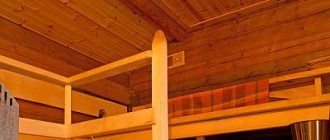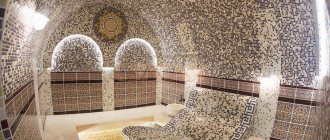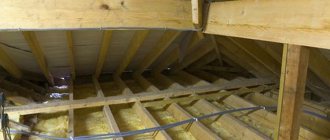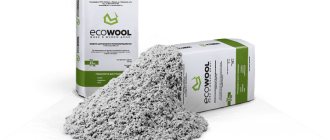Good day, dear guest. If you are on this blog and reading my articles, it means that you are interested in the topic of the bath. I would like to immediately ask this question: what functional feature should every bathhouse have?
That's right - this is the preservation and retention of a warm microclimate indoors for a long time. The ceiling plays the main role in this. The temperature in your steam room, its warm-up time, as well as the absence or presence of certain problems depend on how correctly and well the insulation of the ceiling in the bathhouse is done. Let's look at the question of how to insulate the ceiling in a bathhouse using a specific example.
Here I will describe the process of insulating a false ceiling. In my opinion, this is the most optimal type of ceiling. It is easy and quick to install and can be done with one hand, without helpers. And the installation process itself is quite simple.
First, let's figure out what types of work are included in insulating the ceiling of a bathhouse? First, you need to make a vapor barrier
, that is, to beat off the steam that rises from the ceiling.
The ceiling vapor barrier must be impermeable to water vapor. This is an important condition. Secondly, produce the thermal insulation
. The third and final stage is the installation of waterproofing. So: how to insulate the ceiling in a bathhouse? where and how to start?
From this article you will learn:
Bathroom insulation with penoplex
Content:
- Advantages and disadvantages of penoplex
- Features of thermal insulation of a bath
- Insulation of strip foundations
- Thermal insulation of the bathhouse base
- Bathroom floor insulation
- Thermal insulation of walls
- Insulation of ceiling and roof
Recently, penoplex (extruded polystyrene foam) has become very popular among synthetic thermal insulation materials. It is made by pressing molten foam plastic using a special molding nozzle (nozzle). Under the influence of high temperature and pressure, the structure of the material becomes finely porous with isolated cells measuring 100-200 microns. Thanks to this, it is durable and has high thermal insulation properties.
A good sauna is not only a hot steam room. To make you and your guests truly comfortable, it is necessary to insulate not only the steam room of the bathhouse, but also all rooms without exception: the changing room, dressing room and vestibule. If a sauna or bathhouse has a swimming pool and a gym, they must also be properly insulated.
Summarizing
A good bath is a warm bath. And in order for it to warm up well to the required temperature, it is necessary to choose the right thermal insulation and insulate all structural elements.
The bathhouse is also insulated from the inside:
- Windows, doors and all openings - with natural sealants;
- The outer door is made from good natural materials.
At FORUMHOUSE, the issues of insulating a steam room are discussed in detail, and the insulation of the ceiling of a steam room is discussed separately. Find out how to properly insulate a timber bathhouse from the outside. Read our article about insulating the floor in a bathhouse. Get acquainted with the guide to bathhouse constructions of our users and find the answer to any question about arranging a bathhouse. Watch our video on how to build a full-fledged bath complex.
Bath insulation
| Insulation | In what room is it used? | Note |
| Natural materials: rolled jute, felt, insulation made from reeds and sawdust, moss, tow, etc. | Dressing room, rest room. | Natural materials ignite at high temperatures, so they are not suitable for steam rooms and washrooms. But materials made from jute and flax are the best inter-crown insulation for a chopped bath. There are excellent modern roll insulation materials made from natural materials, but they are very expensive, so they are practically not used for insulating baths. |
| Mineral insulation. | They can insulate any bathhouse. Most often, slab insulation boards (mats) that are easy to install are used. | They do not rot, last up to 30 years, are fire resistant, and inexpensive. Most Russian baths are insulated with these materials. |
| Polymer materials | FORUMHOUSE craftsmen do not recommend it for insulating a steam room. | Polystyrene foam is an excellent heat insulator, but it is flammable, and at high temperatures it releases substances harmful to humans. You cannot use polystyrene foam in the steam room . Extruded polystyrene foam or penoplex is considered a safe material (it is used to insulate the bathhouse of Russian polar explorers in Antarctica). But FORUMHOUSE experts do not recommend using this material in a steam room. |
| Insulation based on aluminum foil. | It is used in accordance with the manufacturer's recommendations for a specific room. | The principle of operation of such insulation is the effect of a thermos, the reflection of heat from the walls and ceiling due to foil. Some types of foil insulation are produced specifically for steam rooms and other rooms with high temperatures, while others begin to release harmful substances when the temperature rises. Foil in the bathhouse is used as a vapor barrier. |
Synthetics
Natural gaskets are superior in terms of benefits and the absence of harmful fumes, but man-made materials are considered more durable. They can be used to upholster the attic of a room once and forget about updating the renovation for several years; this procedure will not cause harm if you follow safety precautions and follow the correct scheme for insulating the ceiling in a bathhouse.
There are the following categories of synthetic insulation:
- polymer;
- mineral wool;
- glass wool;
- foil.
The choice of inorganic materials is very wide. Therefore, in order to find out what insulation to use to insulate the ceiling in a bathhouse, you need to look at its thermal conductivity. Products of chemical synthesis, as a rule, have a higher ability to retain heat than organic matter.
But there are ways to arrange structures by combining materials, for example, laying a peat slab or a layer of earth on top of the foam.
But it is necessary to take into account that when the room becomes too hot, inorganic raw materials emit harmful and even toxic substances. Therefore, the answer to the question whether it is possible to insulate the ceiling in a bathhouse with penoplex foam will be negative.
These slabs are ideal for equipping technical, utility rooms (dressing room) or rest rooms where the temperature does not reach high limits.
Insulating a bathhouse ceiling with mineral wool
The main advantage of this material is its cost-effectiveness. Due to low thermal conductivity, very little raw material is required - 10-15 cm. Slag fiber boards are especially convenient for installation, as they lend themselves well to cutting and transformation.
Unlike natural raw materials, such blocks are not attractive prey for rodents.
The choice to insulate the bathhouse ceiling with basalt wool will be the most optimal, since the material:
- does not deform;
- does not absorb moisture (with special treatment);
- does not burn;
- does not require replacement for many years.
Photo from the site Uvk.vn.ua
There are several subtleties in how to insulate the ceiling in a bathhouse with mineral wool. Without protection and special impregnations, a pressed mineral slab is hygroscopic, so first of all you need to think about protecting the blocks.
- Before laying the sheet on the boards, it is necessary to lay a layer of vapor barrier (polyethylene or foil with metallized layers to the coating).
- Then a pliable material is pressed between the beams.
- Another sheet of foil protection is attached on top with the metal layer facing out.
Several other types of wool are also used - diabase, dolomite, slag. They are superior to folk remedies in terms of their effectiveness and modernity.
Photo from Mastergrad.com
Organic raw materials
Insulating the bathhouse with natural materials will provide a high level of vapor barrier.
The following types of raw materials are distinguished:
- flax tow;
- cellulose;
- felt;
- wood sawdust.
When the question arises of what is the best way to insulate the ceiling in a bathhouse from above, it is worth remembering that some samples of animal or plant origin cannot tolerate high temperatures. They can only be used in the waiting room or rest room.
Method of insulating a bathhouse ceiling with sawdust
Among other techniques, the leader is the procedure for improving the roof of a room using compressed wood shavings. It gained such popularity among the people because of its accessibility and ease of installation.
Photo from the website Tomsk.fis.ru
Considering the fact that thermal insulation should not only prevent hot air from passing out, but also promote the accumulation of steam, it is necessary to lay two layers of blocks. To better distribute the wood processing product between the upper beams, a binder is used, so the bathhouse ceiling is insulated with clay with sawdust or with cement.
Why is it important to keep your steam room warm?
When the structure is put together according to all the canons, but the hot air still quickly leaves the building, it is time to choose the appropriate insulation for the bathhouse ceiling. Why should you think about this part of the room first?
It is no secret that heated air masses are lighter than cold ones and rise rapidly. If the steam room cools down quickly, then there is a problem in the roof.
Photo from Overboss.ru
There are several ways to waste heat:
- leakage through cracks in surfaces;
- cooling of air when circulating between cold objects;
- heat loss when passing through concrete and metal floors.
These shortcomings can be eliminated by competent design of the upper part of the sauna. When insulating the ceiling of a bathhouse, you need to lay out a kind of cake from load-bearing beams, which bear the main load, and heat-insulating elements. The latter are responsible for the absence of condensation and rapid heating of the steam room, which will save on the amount of fuel.
Technology
No matter how good the material is, failure to adhere to the accuracy of the installation technology can, over time, negatively affect the quality of heat conservation.
Frame installation
Required:
- foam sheets;
- metal profile or wooden blocks 50x50;
- film for vapor barrier.
Stages:
- Clean the ceiling from dirt and dust, eliminate unevenness, if any. Treat the surface with an antiseptic.
- Remove electrical wiring. To do this, use a special protective corrugation.
- Attach beams or a profile to the ceiling at a distance of 50 cm. Make sure that the shape of the attached beams takes on the appearance of a large cage, each cell of which should correspond in size to the foam sheet.
- Install foam plastic using dowels or glue.
- Treat joints and cracks with polyurethane foam.
- Attach a vapor barrier layer to the insulation.
- Finally, start installing drywall, wood or other material that matches the overall interior.
Adhesive mounting option
Required:
- sheets of foam plastic in an amount corresponding to the total area of the ceiling;
- adhesive composition.
Stages:
- Clean the ceiling, treat it with an antiseptic and prime it for a better bond between the glue and the surface.
- Prepare an adhesive composition or use a ready-made one.
- Apply glue to the foam sheet (in continuous lines along the edge and in splashes in the center of the board). Press the foam sheet as firmly as possible against the ceiling and hold for a few seconds.
- If you are insulating the ceiling using polystyrene foam, then all the sheets should be prepared in advance: scratch with an iron brush along the working side (the one on which you will apply the adhesive).
- Start gluing the sheets from the middle of the ceiling in a checkerboard pattern.
- For greater reliability, the foam sheets can be additionally attached with dowels after the glue has dried.
- Glue the reinforced mesh on top of the foam and putty.
And here is an article about insulating a bathhouse ceiling with mineral wool.
In this section of our website https://ru-house.net/postrojki/banya/ you will find a lot of useful and interesting information about the bathhouse.
Installation on joists
Insulation of the floor in a bathhouse on screw piles (or for a wooden structure on any foundation) is most often carried out between joists or beams. Unlike the previous method, here you can choose insulation with less strength, since the material does not take the load from furniture and people.
Expanded polystyrene is mounted between wooden floor joists or between floor beams. The floor pie for a wooden bath in this case looks like this:
- subfloor boards (or plywood, DSP, OSB);
- waterproofing;
- insulation between load-bearing wooden beams;
- vapor barrier;
- clean floor.
The insulation is simply laid between the beams. There is no need to use glue or dowels. But it is necessary to fill the gaps between polystyrene and wood with sealant or polyurethane foam.
Proper insulation of the bathhouse will ensure a comfortable microclimate and extend the service life of the building. An increase in construction costs in this case leads to savings in operation.
Waterproofing: what is it for?
The final point in insulating the ceiling is waterproofing. What is it and what is it for? And it is needed in order to release into the attic that steam or moisture that nevertheless got into the insulation and not let it in from the outside. For this purpose, there are special anti-condensation films, as well as polymer films - membranes (a topic for a separate discussion). An example of such material is isospan. You can view and navigate prices here.
We spread such a film over the TechnoNIKOL insulation and shoot it with a stapler around the perimeter and at the bases of the trusses. We seal the joints with tape. Well, the very last stage - this film must be protected. To do this, we lay down edged boards so that you can safely walk around the attic without damaging the waterproofing. All.
What is the conclusion from this? Insulating the ceiling of a bathhouse with your own hands is not such a difficult task. The main thing is to have a desire, a certain amount in your pocket, hands growing where they should be and... I’ve said a lot of things, I’ll finish. And finally, an interesting video about another method of insulating a bath ceiling.
Wisdom Quote: Verbosity usually breeds boredom.
Underfloor heating system
Another option for insulating the flooring in a bathhouse is installing a heated floor system. In this case, you can choose a design based on electric heating elements or water pipes.
Such floors can not only make the floor warm, but also heat the entire room. Therefore, if they are used in a steam room, they can participate in creating the necessary environment. Their location in other rooms of the building will make it possible to move comfortably barefoot.
They are installed in the same way as other insulation materials under reinforced lattice and screed in a concrete floor and between joists under boards in a wooden floor. An important addition is the need to install heat-insulating material under the system to prevent heat loss into the ground.
Main features of the material
Penoplex is essentially a polymer substance with a foamy texture. It is produced by extruding ordinary polystyrene. The use of the most advanced equipment allows us to obtain a material with a strictly ordered structure. In it, small gas bubbles are distributed as evenly as possible. Such pores have a diameter of 0.1 to 0.2 millimeters, they are completely closed and insulated. The foaming component of the material is lightweight varieties of freon, to which carbon dioxide is added. The resulting material is chemically inert, that is, it does not enter into chemical reactions. This eliminates the possibility of the development of processes of rotting or oxidation of the insulation.
It is no secret that the thermal insulation qualities of any material with a foam or porous structure can be significantly reduced in the presence of high humidity. This property is not typical for penoplex. The material slightly absorbs moisture during the first 7 or 8 days, while the pores near the surface of the material are filled. Then the moisture absorption process stops. Thus, the thermal insulation qualities of penoplex practically do not change. In addition, the insulation is completely impermeable to water vapor, which is important in a bathhouse.
There are three types of material:
- Penoplex marked 35.
- Penoplex standard.
- Penoplex-45.
Each variety differs from others in terms of specific density, mechanical strength and thermal efficiency. To insulate floors in bathhouses, the first two types of penoplex are used.
Penoplex insulation, marked 45, has an increased level of mechanical strength and can be used to insulate floors exposed to mechanical loads, as well as various types of vibrations. The dimensions of a standard slab are 60 centimeters wide and vary in thickness from 2 to 15 centimeters. Sales records belong to insulation with a thickness of 10 to 12 centimeters. The length of the slabs can be 120 or 240 centimeters. For large objects, penoplex slabs are produced in 4 and 4.5 meter formats.
How to insulate a ceiling with penofol from the inside
As noted above, foil insulation is not plastered, so it can only be placed under the sheathing. It is advisable, if you want to get a good effect from the thermal insulation of ceilings, to use penofol in combination with other insulation. Therefore, we will consider two options for combining insulation.
- We insulate the ceiling with penofol and mineral wool from the inside.
- Polystyrene foam as an insulation option
- Pros and cons of the material
- Are polystyrene foam and polystyrene foam the same thing?
- Technology
- Frame installation
- Adhesive mounting option
- So is it worth it to insulate with polystyrene foam?
In this case, the sheathing is assembled under the plasterboard and mineral wool is laid between the profiles.
Penofol is fixed on top of the frame and fixed with self-tapping screws (fleas) to the supporting profile, and the foil should be directed into the room. The insulation strips should be laid end-to-end (without overlapping) and taped with special foil tape. Then the frame is sheathed with plasterboard and subjected to subsequent finishing.
You can also use two layers of penofol. The first is attached to the ceiling with the foil facing out, the second, as described above. This makes it possible to achieve excellent insulating and soundproofing effects; in addition, the foil material simultaneously functions as a vapor barrier for mineral wool.
2. Thermal insulation of ceilings with penoplex and penofol.
First, sheets of extruded polystyrene foam are glued to the ceiling, and then secured with dowels.
In this case, you need to try to ensure that the horizontal plane comes out as even as possible. Penofol is glued onto the penoplex, the seams are closed with tape. Thin (about 1.5 cm) wooden slats are secured on top of the foil with dowels, to which plasterboard sheets or PVC panels are attached.
You can use penofol yourself, especially when sound insulation is a priority. This situation can arise in a city apartment, where the ceiling is warm (there is a heated living space above), but the noise from the neighbors above is disturbing. In this case, before constructing the sheathing under the cladding, you need to attach foil material to the ceiling slab, with the aluminum film facing up.
By insulating the ceiling of a bathhouse, you will always be in the black. In any case, a warm ceiling guarantees the preservation of that notorious forty percent that so easily evaporates through thin surfaces and cracks.
Table of contents:
And a bathhouse is a room in which even one percent of the required temperature disappears noticeably, so insulating the ceiling here becomes a priority.
Expanded clay
Ceiling insulation with expanded clay is used in bathhouses that have under-roof spaces (attics, attics). The properties of expanded clay are in many ways similar to those of mineral wool. The same advantages: environmental friendliness, resistance to high temperatures... and the same disadvantage: the material absorbs moisture too well. From below it must be protected from the penetration of steam, and from above - from the effects of atmospheric and condensation moisture.
In addition, the fired granules of this heat insulator have much lower resistance to heat transfer than mineral wool. For this reason, the required thickness of the effective embankment is at least 30 cm.
This option is suitable for large steam rooms. Since the floor beams above spacious rooms have a significant vertical section, deep natural niches are formed for filling the required amount of expanded clay.
Production of vapor barrier
We take rolled foil polystyrene foam approximately 3-5 mm thick. and shoot it with a furniture stapler on the ceiling from the side of the steam room. We install the foil with an overlap of 5 centimeters. All joints must be glued with foil tape. Be sure to lower the foil onto the walls, 10 centimeters down. The foil will protect the ceiling well from the effects of steam.
You need to sew bars onto it, and then on them some kind of decorative finishing (for example, lining). a gap (1.5-3 cm) between the foil and the final finish ,
since the air in this gap is a very good heat insulator.











